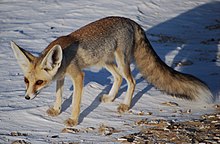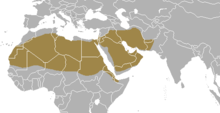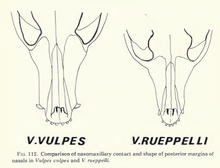Rüppell's fox
| Rüppell's fox[1] | |
|---|---|

| |
| Scientific classification | |
| Kingdom: | |
| Phylum: | |
| Class: | |
| Order: | |
| Family: | |
| Genus: | |
| Species: | V. rueppellii
|
| Binomial name | |
| Vulpes rueppellii (Schinz, 1825)
| |

| |
| Rüppell's fox range | |
Rüppell's fox (Vulpes rueppellii), also spelled Rueppell's fox and also called the sand fox, is a species of fox living in North Africa and the Middle East, from Morocco and the Sahel region to the Afghanistan hills and SW Pakistan[1] It is named after the German collector Eduard Rüppell. Rüpell's fox is also called the sand fox, but this terminology is confusing because the corsac fox (Vulpes corsac) and the Tibetan sand fox (Vulpes ferrilata) are also known as the "sand fox".
It has an average life expectancy of up to 6 or 7 years in the wild, but can live much longer in captivity.
Description
Rüppell's fox is 40-52 centimeters (15.75-20.5 inches) long and has an average weight of 1.7 kilograms (3.75 lbs). It is a very small canine, and is considerably smaller than the red fox. It is sandy in color and has black patches on the muzzle, as well as a white tipped tail. Rüppell's fox has fur on the pads on its feet, that possibly helps distribute their weight and move easily on sand, and definitely keeps the hot sand from burning their feet. Similar to other desert dwelling foxes, Rüppell's fox has massive ears to cool it off. The tail is long and bushy. These features make Rüppell's fox look almost like a large fennec fox.
Behavior


Rüppell's fox relies on scent glands for many activities. It uses them to mark territories as well as to spray unwanted predators, similar to the behavior of the skunk. The female Rüppell's fox uses her scent glands to mark the cubbing den. Another use for the scent glands is that the foxes use them to greet each other. Rüppell's fox can bark, in a way similar to a dog.
Around mating season, Rüppell's fox travels in monogamous groups, or a male and a female, but after breeding season, the fox reportedly moves in family groups of 3-15 individuals. One animal occupies about 50-69 square kilometers of territory, though the male's territory is larger than that of the female's. Rüppell's fox is nocturnal and gregarious. The animals change dens often, and will abandon a den if there is a dangerous disturbance in the area. Most dens are dug under rocks, or under trees.
Rüppell's fox was pushed to living in the desert biome due to competition with its larger cousin, the red fox. It is known as being an extremely good survivor. Rüppell's fox's only predators are the Steppe Eagle and the Eagle Owl.
Diet
Rüppell's fox is a solitary forager. It is an omnivore, and will eat almost anything that crosses its path. Mostly, it is an insectivore, but its diet also consists of tubers and roots, as well as small mammals, reptiles, eggs, and arachnids.
Reproduction
The female Rüppell's fox has a gestation period of around 51–53 days. She has 2-3 kits, and each are born blind. They are weaned at 6–8 weeks of age. They are born underground, to protect them from predators.
Interaction with humans
For the past 100 years, Rüppell's fox has been treated like a pest. Rüppell's fox preys on many livestock animals in Arabia, including chickens, lambs, and young goats.
Conservation status
Rüppell's fox has no conservation status as of now, for it is too hard to estimate the actual numbers. As such, the IUCN lists them as Data Deficient.[2]
Subspecies
There are five subspecies of this fox:[1]
- Vulpes rueppellii rueppelli
- Vulpes rueppellii caesia
- Vulpes rueppellii cyrenaica
- Vulpes rueppellii sabaea
- Vulpes rueppellii zarudneyi
Rüppell's fox in philately
The Libyan Posts (General Posts and Telecommunications Company, GPTC) in cooperation with WWF (World Wide Fund for Nature), dedicated a postal stamps issue to Rüppell's fox on May 1, 2008. The issue is made of a set of four stamps printed in minisheet of two sets. The issue was completed with a special First day of issue Cover having a special postmark.[3]
References
- ^ a b c Wozencraft, W. C. (2005). "Order Carnivora". In Wilson, D. E.; Reeder, D. M. (eds.). Mammal Species of the World: A Taxonomic and Geographic Reference (3rd ed.). Johns Hopkins University Press. pp. 532–628. ISBN 978-0-8018-8221-0. OCLC 62265494.
- ^ a b Template:IUCN2008 Database entry includes justification for why this species is listed as least concern
- ^ Libyan Stamps online

